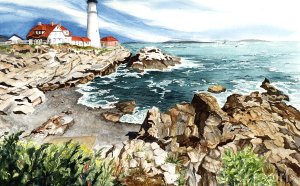
Italian High Renaissance Painter
|
Greatest High Renaissance Painters Its greatest exponents were the Florentine geniuses Leonardo da Vinci and Michelangelo, together with the Urbino master Raffaello Santi - known as Raphael - and the Venetian colourist Tiziano Vecellio - known as Titian. Other important High Renaissance painters include Andrea del Sarto (1486-1530) and Fra Bartolommeo (1472-1517) in Florence, Giovanni Bellini (1430-1516), Giorgione (1477-1510) and Sebastiano del Piombo (1485-1547) in Venice. That said, the story of the High Renaissance is closely associated with the Renaissance in Rome, where ambitious Popes including Julius II (1503-13) and Leo X (1513-21) financed a wide range of public art projects to ensure that the city surpassed Florence as the greatest cultural centre in Italy. In fact, both Florence and Rome became key stop-overs in the European Grand Tour of the 18th century. Important artists active outside the major centres, include Antonio Allegri da Correggio (1489-1534), the creator of the highly influential fresco the Assumption of the Virgin (Parma Cathedral) (1526-30). Leonardo Da Vinci (c.1490 onwards) The advanced style of painting practiced by Leonardo da Vinci in Milan was continued with modifications in Lombardy by his principal Milanese follower Bernardino Luini (c.1480-1532) and others. It found no immediate converts in his native Florence, however, even though his unfinished panel painting "Adoration of the Magi" remained close by the city, in the Monastery of San Donato a Scopeto. Some contemporaries of Leonardo, such as Botticelli, Domenico Ghirlandaio, and Filippino Lippi did imitate the broad outlines of the picture, but they failed to absorb its deeper and more innovational features. The real impact of Leonardo's painting was seen only when he returned to Florence in 1500. Fellow artists and members of the public flocked to the church of the Santissima Annunziata to see his full-scale study for The Virgin and Child with St. Anne. His great mural depicting the Battle of Anghiari (1503-06) competed with work by his rival Michelangelo in a civic competition to record the history of Florence. Neither the panel nor the mural was ever finished. Even so, his art left an abiding impression on his native city. More was to come. His masterpiece (La Gioconda), now in the Louvre, revolutionized portraiture, with its innovative shading technique - sfumato. (See also his earlier Lady with an Ermine, 1490, Czartoryski Museum, Krakow.) Among those greatly influenced by Leonardo's handling of light and shade was Fra Bartolommeo (1472-1517), later leader of the Florentine High Renaissance. In addition, his Renaissance drawings stimulated both fellow artists to make similar preparatory studies for their paintings, and patrons to collect them. Above all, his reputation as an artist - who was also a scientist and scholar - rubbed off on his fellow artists, leading to improved opportunities and status for all. Raphael (1483-1520) The artist who assimilated most from the painting of Leonardo was undoubtedly Raphael. Son of the painter and writer Giovanni Santi, he was greatly influenced in his early days by Perugino (1450-1523). At the age of 21 he came to Florence as a respected artist, only to discover to his consternation that everything he had learned was old-fashioned and ultimately provincial. His immediate response was to set about learning the new style from the Florentines, including provincial artists working in Florence, such as Luca Signorelli (1450-1523). Out went his old style of drawing, with its tight contours and interior hatching; in came the more flowing style of Leonardo. From a close study of Leonardo's he came up with a new type of Madonna set against a soft and gentle landscape (The Madonna of the Goldfinch, Uffizi). He borrowed the format of Leonardo's Mona Lisa for his portrait paintings, and he also made a meticulous study of Michelangelo's sculpture. Within 5 years, by the time he left for Rome in 1509, Raphael had absorbed all Florence had to offer and was poised to make his own artistic statement. Located on the upper floor of the Vatican palace, the Stanza della Segnatura was used by the ageing pontiff Pope Julius II (1503-13) as a library. It was here, between 1509 and 1511, that Raphael painted his famous fresco . It was the room's second mural painting to be completed, after La Disputa, on the opposite wall, and is regarded as one of the clearest and finest examples of the High Renaissance style. In this work, like Leonardo before him, Raphael creates a balance between the movement of the figures and the order and stability of the pictorial space. He populated the composition with numerous figures in a diverse variety of poses, yet manipulated these poses so as to finally lead the eye of the spectator to the central pair of Plato and Aristotle whom he made the converging point of his system of linear perspective. A masterful example of High Renaissance painterly technique. See also his wonderfully harmonious Sistine Madonna (1513-14, Gemaldegalerie Alte Meister Dresden). Michelangelo (1475-1564) While the 26-year old Raphael was frescoing the Vatican apartments, the 33-year old Michelangelo Buonarroti was (against his will) decorating the ceiling of the Sistine Chapel (1508-12) with his . Although trained in fresco painting by Domenico Ghirlandaio - and influenced by others... |
YOU MIGHT ALSO LIKE



Share this Post
Related posts
Maine paintings
Even before the Farnsworth Art Museum opened its doors on August 15, 1948, it had already set a goal to build a collection…
Read MoreAbstract Painting Workshops
This is a five-day workshop. In this workshop we explore the idea that working in series is a process. Whether the resulting…
Read More





